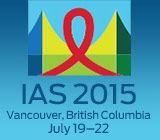 Research into how the body metabolizes the antiretrovirals in Truvada (tenofovir/emtricitabine) suggests that experimental non-daily-dosing protocols for pre-exposure prophylaxis (PrEP) offer high protection against HIV infection through anal sex, while vaginal sex protection is up for debate, aidsmap reports. Researchers presented from the IPERGAY trial as well as a small study looking specifically at Truvada metabolization presented findings at the 8th International AIDS Society Conference on HIV Pathogenesis, Treatment and Prevention in Vancouver, British Columbia.
Research into how the body metabolizes the antiretrovirals in Truvada (tenofovir/emtricitabine) suggests that experimental non-daily-dosing protocols for pre-exposure prophylaxis (PrEP) offer high protection against HIV infection through anal sex, while vaginal sex protection is up for debate, aidsmap reports. Researchers presented from the IPERGAY trial as well as a small study looking specifically at Truvada metabolization presented findings at the 8th International AIDS Society Conference on HIV Pathogenesis, Treatment and Prevention in Vancouver, British Columbia.
In the IPERGAY trial, French and Canadian men who have sex with men (MSM) were instructed to take a double dose of PrEP two to 24 hours before anticipated sex and one daily dose each day after actually having sex. The study, which was stopped early in October 2014 when it became clear that the dosing strategy was highly effective, had an 86 percent success rate at reducing HIV incidence among the participants assigned to take PrEP.
Eighty-one percent of the partcipants reported taking PrEP the last time they had sex, with 53 percent reporting taking all required doses. Eighty-two to 91 percent of participants had detectable tenofovir in their blood at the study visits they made every other month. The blood levels suggested that 80 to 85 percent of the participants took PrEP at least once during the week leading up to the study visits.
Participants in a substudy of IPERGAY were given a single double dose of Truvada. Researchers took blood samples and rectal biopsies after a respective 30 minutes, one hour and 2,4, 8 and 24 hours. They cultured the biopsies with HIV to determine how well Truvada protected against the virus. While only 30 minutes was required for emtricitabine to reach a protective level, 24 hours had to pass before tenofovir reached a fully protective level.
The double dose offered twice the overall drug exposure, but only reduced the risk of infection by 40 percent if taken in isolation—not bookended by other doses. This underscored the importance of the two post-sex doses for men who do not already have Truvada in their systems before taking the pre-sex double dose (for example, if a considerable amount of time has passed since their last post-sex dose).
The second study examined Truvada metabolization among 19 HIV-negative individuals and found that tenofovir levels in cervical tissue cells only ever reached a level one tenth that of rectal tissue cells. Maximum drug levels in the rectum were reached after five days of Truvada, compared with 10 to 12 days in the cervix.
According to this study, one, two and three doses of tenofovir lead to a respective 77 percent, 89 percent and 98 percent reduction in anal sex HIV risk. If someone takes Truvada each day for a month and then stops, the anal sex protection yielded from the drug remaining in the body 24 hours, three, five and seven days later is an estimated 97 percent, 96 percent, 93 percent and 90 percent, respectively. It is not known what the corresponding figures are for vaginal sex protection.
To read the aidsmap article, click here.
Advertisement
Advertisement
Advertisement






1 Comment
1 Comment